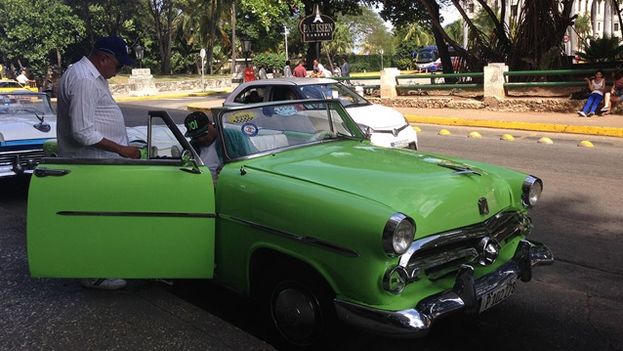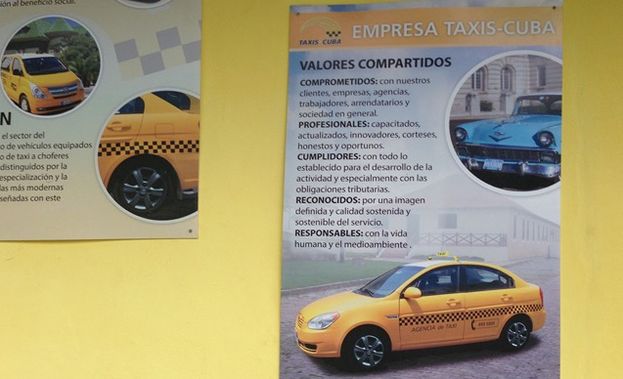
14ymedio, Marcelo Hernandez, Havana, 4 November 2016 — For tourists coming to Cuba, one of the most cherished fantasies it is to get into a car of the last century and cruise the streets of cities and towns. A new type of permit for private carriers is bringing that dream even closer to reality, as it authorizes the drivers to operate at airports and in the vicinity of hotels.
Since early this year in the streets of Havana you can see that the best-preserved models of Chevrolet, Oldsmobile, Cadillac and Ford displaying a yellow sticker on their windshield. It is the carte blanche to park outside hotels and legally offer their services to foreigners.
Previously, the areas of the Cuban capital most frequented by tourists were a feudal estate, where the only legal operators were the so-called Panataxis and the vintage cars owned by the government. The self-employed had to settle for picking up tourists on the periphery or managing the business through intermediaries.
The mouth-watering market for tours in convertible cars for recently arrived visitors, costing between 40 and 50 Cuban convertible pesos (CUC) per hour (about $40-50 US), is attractive to drivers everywhere. Antonio Martinez, 52, is one of those who long to get the “yellow sticker” that would “turn a pumpkin into a carriage,” as he says sarcastically about his old Toyota jeep.
“I’m getting less and less business on the route between Santiago de las Vegas and Fraternity Park,” the driver explained to this newspaper. The entrepreneur spent more than five years working as a collective taxi driver focused primarily on domestic customers.
However, since the middle of this year local authorities have imposed price caps and “business is getting worse,” said the driver. “Many are switching to this type of work with tourists, because it always pays better and there’s the tip on the side,” he adds.
Following a decision by Havana’s Provincial Administration Council, it was established that the carriers cannot decide to raise fares on their own, and only the prices charged before July 1 are acceptable. The majority of drivers have shortened their routes and others make deals with the riders not to reveal to the inspectors the actual fares paid.
But Martinez is tired of this “cat and mouse game.” After an investment of more than 2,000 convertible pesos to make his car “as smooth as silk,” the driver has begun the process to obtain the longed-for sticker that would allow him to “carry Pepes without having to be hiding around corners,” he says.
Competition is strong, because of the more than 496,400 people throughout the island who were engaged in self-employment at the beginning of this year, at least 50,482 carry cargo and passengers. But there is a very small number who have cars “in the impeccable condition that is lovely in the eyes of the tourists,” says Martinez.
Asking around among other drivers who already have the sticker to operate in tourist areas and make “airport pickups,” led the self-employed driver to the No. 9 taxi base on Ayestaran street.

It was not as easy as he thought. The director of the state agency, Ernesto Reyes, first described to him the simplest requirements to achieve his goal, including “opening two bank accounts, one in national currency and another in convertible pesos, and taking out the operating license needed by all taxi drivers.”
To not lose the sticker, drivers must pay about 25 CUC and the same amount in national currency, the Cuban peso. “With that you will be allowed to park outside Havana hotels and may take or collect clients at the airport, but it is not valid to go to Varadero beach,” said Reyes.
The most insurmountable barrier is that with the new permit the driver is required to “consume 90 gallons of fuel monthly” that must be purchased at the taxi base on Ayestarán Street at a total cost of 360 CUC. The measure seeks to prevent the self-employed from turning to the informal market to buy their fuel*.
Antonio Martinez has decided to “leave the yellow sticker for another time” because, he said, “rather than a permission, it seems like a shackle.”
*Translator’s note: The “informal market,” in this and other cases, is essentially state resources that have been “diverted” (stolen) for sale on the black market. Much of the Cuban economy – at all levels, from households to businesses – is supported by “under the table” purchases of diverted state resources.
